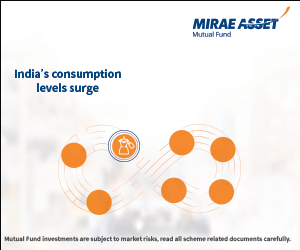ICICI Prudential Credit Risk Fund: A good debt fund for investors seeking higher yields

Credit risk funds are debt mutual fund schemes which aim to capture higher yields by investing in AA or below rated corporate bonds (Non-Convertible Debenture). Lower rated bonds pay higher coupon rate to investors and by investing slightly lower rated bonds, fund managers aim to capture higher yields for investors. Credit risk funds tend to give higher returns than usual short duration (short term) debt funds.
To put this in perspective of yields, the yield to maturity (YTM) of ICICI Prudential Credit Risk Fund, a credit risk fund is 9.7%, while the average YTM of short durations fund category is 8.6%. It should be no surprise that ICICI Prudential Credit Risk Fund gave 0.8% higher returns than short duration funds category average in the last 12 months.
Smart investors use credit risk funds to lock in higher returns in the medium term especially in an increasing yield interest rate environment – the 10 year G-Sec yield is near its 3 year high. The YTM of ICICI Prudential Credit Risk Fund portfolio increased from 8.8% to 9.7% within a year (please see the chart below).

Source: ICICI Prudential
Investors can lock in these high yields in the medium term, but they should ensure that their investment tenor matches (or exceeds) the average maturity of the ICICI Prudential Credit Risk Fund bond portfolio, which is around 2 years. We should caution investors that they should not translate YTMs into returns because of fund expenses, portfolio changes / churn etc. A high YTM is indicative of good returns over the period of residual maturity of the bond portfolio in an accrual based debt fund.
Understanding credit risk
When investing in credit risk funds, investors should have clear and rational understanding of risk factors before investing. The name credit risk fund may sound scary to many retail investors because they fear something is wrong – a clear understanding of credit risks and how they are managed in a credit risk fund will hopefully, clarify misconceptions and help investors make informed decisions. Investors should understand that there are several grades of credit risk – these grades are indicated by the credit rating of the bonds. AAA rating is the highest credit rating, which denotes high degree of safety, AA is the next highest credit rating followed by A, BBB, BB, B etc. Each credit rating grade denotes a risk grade. The table below shows the

Just because a Non Convertible Debenture (NCD) is rated BB or B, investors should not assume that it will default and the investor will make a loss. Similarly, just because a NCD is rated AAA, there is no guarantee that it will never default. Credit rating of NCDs can change over time; an AAA rated NCD can get downgraded to AA or A rating, at the same time, a BBB rated NCD can upgraded to A or AA rating. The price of the NCD (bond) is directly related to rating changes – if a NCD gets downgraded, then the price of the NCD will fall and if it gets upgraded then the price will rise.
How fund managers manage credit risk?
Good credit risk fund managers aim to optimize risk and yields. They try to achieve this by allocating a major share of their portfolio to highly rated papers (AA and above for NCDs and A1 for commercial papers). The lower rated papers provide a booster to income through higher yields but since the exposure is limited, the overall risk is small. Even in the worst scenario of a default, the overall portfolio can still generate sufficiently good returns. The waterfall chart below shows the credit risk distribution in ICICI Prudential Credit Risk Fund portfolio.

Source: ICICI Prudential Factsheet
ICICI Prudential Credit Risk Fund aims to generate income through investing predominantly in AA and below rated corporate bonds while maintaining the optimum balance of yield, safety and liquidity. Prudent risk management is evident in the chart above - more than 80% of the portfolio is high quality (high safety). The fund manager also aims to invest in NCDs which have the potential to receive a ratings upgrade. Recently two securities in the fund portfolio had their ratings upgraded.
Here, you must read – why you should not ignore debt mutual funds
Investors may have heard horror stories of how corporate bond downgrades / defaults caused negative returns in some corporate bond funds – the problem in those cases was excess exposure to a particular bond issuer. In ICICI Prudential Credit Risk Fund, the maximum concentration in one issuer is 5.5% and that NCD is AAA rated. The second highest concentration is 3.5% and individual exposure to all other issuers is less than 3%. The fund has 88 securities in its portfolio and average concentration is 1.1%.
ICICI Prudential Asset Management Company has robust risk monitoring and management mechanisms. The AMC has a superb track record in managing debt mutual funds. In our opinion, investors should look at the track record of the AMC especially when investing in credit risk funds. ICICI Prudential Credit Risk Fund has an AUM of over Rs 10,880 Crores. Though I generally do not give much importance to AUM, the AUM of the fund shows the confidence of investors in the AMC.
Did you know which mutual funds is best to invest in lieu of fixed deposits
Rolling Returns of ICICI Prudential Credit Risk Fund
The chart below shows the 1 year rolling returns of ICICI Prudential Credit Risk Fund, previously known as ICICI Prudential Regular Savings Fund, since inception.

Source: Advisorkhoj Rolling Returns Calculator
The average yearly rolling return of ICICI Prudential Credit Risk Fund since inception was 8.92% and the median year rolling return was 9.33%. The maximum rolling return was 12.63%, while minimum rolling return was 5.11%. The fund gave 8%+ annualized returns around 75% of the times since inception and double digit returns around 25% of the times.
The relatively stable rolling returns of ICICI Prudential Credit Risk Fund shows prudent risk management, which is very important for these types of fund. The rolling returns show that there were negative credit risk surprises. The two periods when the fund gave below 6% returns, coincided with extraordinary periods for global bond markets, both linked to actions of the US Federal Reserve. As far as interest rate risk is concerned, the modified duration of ICICI Prudential Credit Risk Fund is 1.56 years, which implies that the fund’s sensitivity to interest rate (yield) changes in limited.
Conclusion
With bond yields rising over the last 12 months, investors have the opportunity of capturing high yields along with the credit spread to get good returns in the medium term. As with any corporate bond fund or credit risk fund, investors should be vigilant about deterioration in credit quality. The strong track of ICICI Prudential Credit Risk Fund and ICICI Prudential AMC can give investors the confidence that risks will be prudently managed. Investors should consult with their financial advisors if ICICI Prudential Credit Risk Funds is suitable for their investment needs.
We also suggest you to read: Debt mutual fund investments – What are the myths versus reality
Mutual Fund Investments are subject to market risk, read all scheme related documents carefully.
Queries
-
What is the benefit of mutual fund STP
Aug 29, 2019
-
How much to invest to meet target amount of Rs 2 Crores
Aug 26, 2019
-
Can I achieve my financial goals with my current mutual fund investments
Aug 24, 2019
-
Can you tell me return of various indices
Aug 19, 2019
-
What would be the post tax return on different investments
Aug 18, 2019
-
Which Principal Mutual Fund scheme will be suitable for my retirement corpus
Aug 16, 2019
-
What is the minimum holding period for availing NCD interest
Aug 4, 2019
Top Performing Mutual Funds
Recommended Reading
Fund News
-
Edelweiss Mutual Fund launches Edelweiss BSE Internet Economy Index Fund
Apr 25, 2025 by Advisorkhoj Team
-
Bajaj Finserv Mutual Fund launches Bajaj Finserv Nifty 50 Index Fund
Apr 25, 2025 by Advisorkhoj Team
-
SBI Mutual Fund launches SBI Income Plus Arbitrage Active FOF
Apr 23, 2025 by Advisorkhoj Team
-
Motilal Oswal Mutual Fund launches Motilal Oswal Infrastructure Fund
Apr 23, 2025 by Advisorkhoj Team
-
Groww Mutual Fund launches Groww Gilt Fund
Apr 23, 2025 by Advisorkhoj Team













